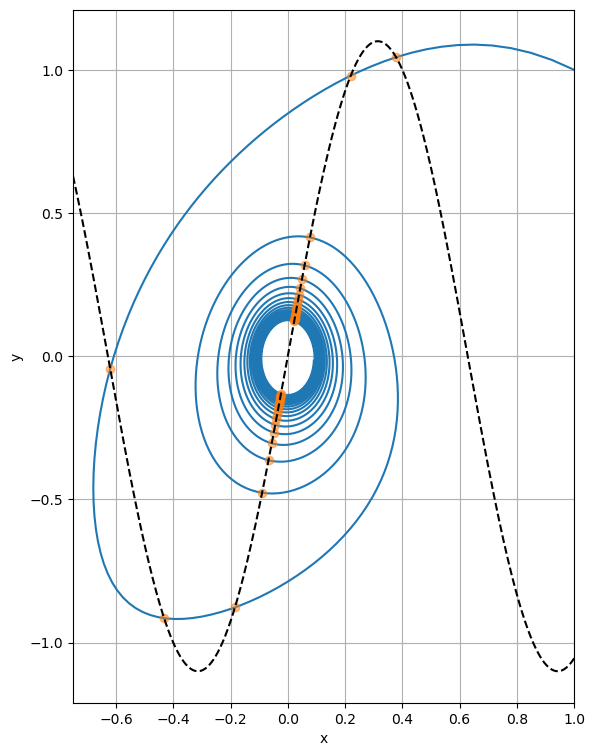Sampling events#
In this example, we will show how to use heyoka.py’s event detection system to detect when the solution of a system of ODEs satisfies certain constraints.
We will be considering the system of polynomial ODEs
with initial conditions
Let us begin by creating the symbolic variables and defining the system of ODEs:
import heyoka as hy
x, y = hy.make_vars("x", "y")
eqns = [(x, -y - x**2), (y, 2 * x - y**3)]
As a first step, we want to detect when the solution crosses the \(x\) axis. The equation for this event is simply
Each time the solution crosses the \(x\) axis, we want to record in a list the \(x\) coordinate at the time of crossing. Thus, we define the following callback for the event:
# The list of values of the x coordinate
# at the time of crossing.
ev_x = []
# The event's callback.
def cb(ta, time, d_sgn):
# Determine the state of the system
# at the time of crossing.
ta.update_d_output(time)
# Add the x coordinate at the time
# of crossing to ev_x.
ev_x.append(ta.d_output[0])
We can now proceed to the creation of the integrator:
ta = hy.taylor_adaptive(
eqns,
[1.0, 1.0],
nt_events=[
hy.nt_event(
# The event equation.
y,
# The callback function.
cb,
)
],
)
The event is created as a non-terminal event, as it is just a logging event that does not alter the state or the dynamics of the system.
We can then proceed to the integration of the system over a time grid:
import numpy as np
grid = np.linspace(0, 80, 2000)
out = ta.propagate_grid(grid)
Let us plot the solution and mark the \(x\) axis crossing positions:
from matplotlib.pylab import plt
fig = plt.figure(figsize=(9, 9))
ax = plt.subplot(111)
ax.set_aspect("equal", adjustable="box")
plt.plot(out[5][:, 0], out[5][:, 1])
plt.plot(ev_x, [0] * len(ev_x), "o", alpha=0.5)
plt.xlabel("x")
plt.ylabel("y")
plt.xlim((-0.75, 1))
plt.grid()

The plot shows how the event detection system indeed fired each time the solution crossed the \(x\) axis.
Let us now complicate things a bit: instead of detecting when the solution crosses the \(x\) axis, we want to detect when the solution intersects the non-linear curve
The only thing we need to change in our setup is the event equation, which will now read
rather than simply \(y=0\). Additionally, we will also need to store explicitly the \(y\) coordinate of the crossing points. Let us take a look at the code:
fig = plt.figure(figsize=(9, 9))
# Lists of x/y coordinates for the crossing points.
ev_x = []
ev_y = []
# The (updated) callback function.
def cb(ta, time, d_sgn):
ta.update_d_output(time)
ev_x.append(ta.d_output[0])
ev_y.append(ta.d_output[1])
# Reset the integrator with the new event.
ta = hy.taylor_adaptive(
eqns, [1.0, 1.0], nt_events=[hy.nt_event(y - 1.1 * hy.sin(5 * x), cb)]
)
# Integrate over a time grid.
out = ta.propagate_grid(grid)
# Plot the results.
ax = plt.subplot(111)
ax.set_aspect("equal", adjustable="box")
plt.plot(out[5][:, 0], out[5][:, 1])
plt.plot(ev_x, ev_y, "o", alpha=0.5)
# Plot also the curve.
xrng = np.linspace(-0.75, 1, 2000)
plt.plot(xrng, 1.1 * np.sin(5 * xrng), "k--")
plt.xlabel("x")
plt.ylabel("y")
plt.xlim((-0.75, 1))
plt.grid()

The plot shows again how the event detection system was able to correctly detect the intersections of the solution with the curve.

